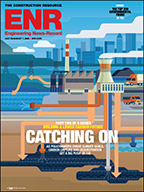Worldly Pursuits
Following clients to new global markets benefitted Top 200 firms in 2013, with energy production environmental support a strong driver but also some resurgence in mining-sector needs, participants say.
Companies' Australia revenue, overall, grew 10.7% in 2013, with the continent a hotbed of merger-and-acquisition activity. Sydney-based GHD joins the list this year through its just completed acquisition of Top 200 U.S.-based veteran Conestoga-Rovers & Associates and with a combined 2013 revenue total. Kleinfelder's Siegel says, "Our Australian growth, which has been significant in an otherwise weak market, has been driven by a combination of our existing U.S. clients spending money there, new clients we acquired when we purchased two environmental firms, and clients we landed once we were firmly established."
Even with continuing fits and starts, Canada cemented its position as the list's largest non-US revenue region. "In Canada, we're seeing good wins in a not particularly strong market," says Pietro Jarre, vice president of Ontario-based Golder Associates. "There is an important opening we see around sustainability and the management of environmental impacts," he says.
The firm and others also point to growth in Asia, even though the sector fell by 6.4% as a whole for the Top 200. Jarre cites the need for industrial hygiene services, pressure to reduce environmental impacts "up and down the supply chain" and management of climate-change impacts. "For the environmental industry, Asia is a land of opportunity and of growing demand for services," he says.
ECC hopes to grow its international markets to diversify away from flattening federal markets. CEO Manjiv Vohra admits that some large international opportunities "may take some time to catch traction."
Other executives note still-high political instability and other project risks in parts of the Middle East, Latin America and Africa. Jarre says unconventional oil and gas production in Argentina "could be a big opportunity for environmental firms, but there are barriers in contracting requirements, so that is a frozen opportunity at this time." He also points to strong opposition to planned mines in Peru.
While mergers and acquisitions in 2013 fueled revenue growth for the Top 200, the trend already shows signs of more intensity in 2014.
One new name on the list, at No. 26, is North Star Group Services, a holding company created by the early 2014 merger of cleanup firms LVI Services and NCM, which previously were ranked separately.
CB&I appears for the first time, with 2013 its first full year as the parent of The Shaw Group. Set to be finalized in October is the mammoth acquisition of No. 2 on the list, URS Corp., by No. 8, AECOM Technology Corp.
While consolidation has propelled Apex Cos. up the list, CEO Peter Cerebelli expects about 10% organic growth this year, fueled by work in the commercial real estate, energy and coastal resiliency sectors.
Meanwhile, Top 200 firms continue to push technology and innovation to serve clients in new ways and gain a competitive edge. MWH Global, Kleinfelder and other firms collaborated last year to complete an innovative engineered wetland and park in Cambridge, Mass., that filters urban stormwater runoff and has been widely touted by peers.
Locus Technologies added clients such as Monsanto and Exelon for its unique cloud-based environmental data management system, which cuts operating costs and offers "an intuitive interface," says CEO Neno Duplan. "This isn't a product of different solutions pieced together to look like one. It is the whole solution," he says.
EarthCon Consultants Inc. is hoping to gain an edge against its larger sector peers through innovations such as its trademarked groundwater plume-stability software. The system, for which the firm is seeking a patent, allows it to show clients through visualization whether pump-and-treat systems are actually shrinking contamination plumes.
"We got regulators to turn off 15 systems at one Michigan site," says company President Timothy Goist. "Most clients get a report that's full of text and data. We want to treat environmental challenges as business solutions, not just as science projects."
Data management by Andrea Pinyan, Mev Barton and Gary Tulacz







Post a comment to this article
Report Abusive Comment